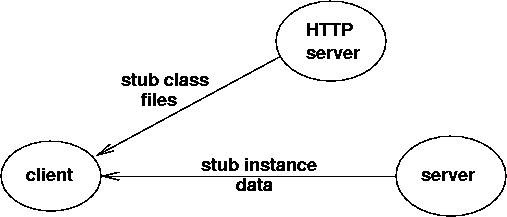Java Remote Method Invocation
Java RMI
-
RMI is a cross between remote procedure call and mobile objects
-
A server-side object is created, along with a stub object
-
Both the server-side object and the stub implement
a "well known" interface
-
The server-side object remains on the server, and receives
and executes remote method calls
-
The stub is moved as a mobile object to a client
-
The client makes calls on the stub which makes remote calls
on the server-side object

Downloading classes
-
Both the client and the server object implement an interface
known to both
-
The class files for this interface must be in the
CLASSPATH of both the client and the server
-
If you don't know the interface, you can't use RMI
-
The class files for the stub will usually be loaded from
a different machine to the client's machine
-
The class files for the stub are usually placed on an HTTP server
 <
<
Generating stubs
RMI requirements on interfaces
-
To use RMI, you start with an interface that both client
and server will know about
-
This interface must also satisfy some requirements for RMI
-
The interface must extend the
Remote
interface
-
Every method must be declared to throw a
RemoteException
-
e.g.
-
Later:
-
Your implementation does not have to throw any
exceptions: they will be thrown by the stub.
But you have to declare them anyway
-
The parameters and result in any implementation
must either be remote objects too, or implement
java.io.Serialisable
Remote object implementation
-
An implementation must implement the "well known" remote interface
-
It usually subclasses
java.rmi.server.UnicastRemoteObject
-
It must have a zero args constructor
-
e.g.
Remote object server
-
Every remote object must have a server
-
The role of the server is
-
create the object
-
export it to the RMI runtime system - this is done
automatically by the zero args constructor
-
make it publically visible in some way
-
stay alive to respond to calls on the object -
this is done automatically by the RMI runtime
because it spawns another thread during construction
-
Let the client know where the class files are stored.
This is done by setting the property
java.rmi.server.codebase to a URL
-
e.g.
Client
-
The client must locate the service in some way
-
Once it has done this, it can make calls on the client
-
e.g.
Advertising and finding objects
Security
-
RMI downloads remote objects which run within the client's JVM
-
This code could do malicious things
-
A security manager protects against harmful code
-
The
RMISecurityManager should be used when
dealing with remote code
Complete example code
-
Interface
-
Implementation
-
Server
-
Client
-
Permissive policy file (save as
policy.all)
grant {
permission java.security.AllPermission "", "";
};
-
Run in separate windows each of the following commands
rmiregistry
java -Djava.rmi.server.codebase=... Server
java -Djava.security.policy=policy.all Client
Non-remote objects
-
A remote method call may have parameters or result
that are themselves objects
-
The parameter may be a variety of objects
-
It could be the stub for a server-side object
-
It could be a client-side object that has a stub
that can be exported
-
It could be a client-side object that is
Serialisable
-
It could be a client-side object that does not have an
exportable stub and does not implement
Serialisable -
this is an error and will either throw an exception or
pass a null object
-
The result may be
-
A server-side object with a stub that can be exported
-
A server-side object that implements
Serialisable
-
A server-side that does neither - this is an error
Example
A FireStation may have a method
FireEngine raiseAlarm(FireEvent evt)
A home may get a stub for a fire station, to raise alarms when a fire event
occurs. In return, it gets a fire engine.

Under the hood - UnicastRemoteObject
-
A remote object usually inherits from this class, or calls
exportObject() on it
-
When an object is exported, a server is set up to listen to
remote requests for the object
-
The server reads requests from the network, unmarshals them,
calls methods on the remote object, marshals the result
and sends it back
-
The class also creates a stub object using reflection
Under the hood - stub object
-
An RMI server programmer never sees the stub object
-
Special code in the Java runtime looks out for remote objects
and substitutes the stub object - this is a bit strange
-
For example, in
Naming.rebind(Remote), the
stub is substituted and sent to the naming service
JRMP
-
JRMP is Java Remote Method Protocol
-
It defines the wire format for RMI messages
Alternative mechanisms
-
RMI is similar to CORBA and other remote method/procedure call systems
-
So it should be possible to have RMI-like mechanisms in these other systems
-
RMI-IIOP is RMI for CORBA, using the CORBA wire format IIOP
-
Jeri (Jini extensible remote invocation) is a cleaned-up version of RMI
that can use lots of different transport mechanisms
RMI-IIOP
-
CORBA allows objects in different languages on different machines to interact
-
RMI allows Java objects on different machines to interact
-
If an interface is defined as both an RMI and a CORBA interface, then
it is possible to create both RMI and CORBA objects
-
The
rmic stub generator has options to create the RMI stub
which uses IIOP instead of JRMP
-
By then treating it as a CORBA object, it can be run from a CORBA server,
registered with a CORBA naming service or accessed by a CORBA client
-
This is Java-specific - you cannot get a Java RMI object to talk to
a C++ object
-
The mechanism is supported by Enterprise Java Bean containers
Jan Newmarch <jan@newmarch.name>
Last modified: Tue Sep 19 15:22:51 EST 2006


 <
<